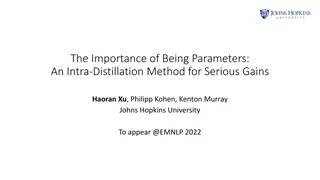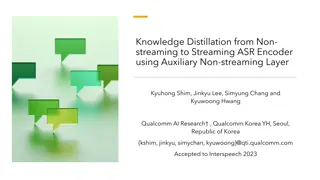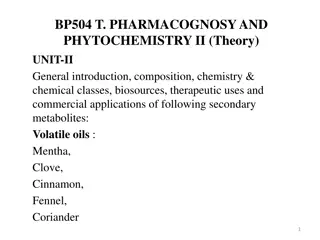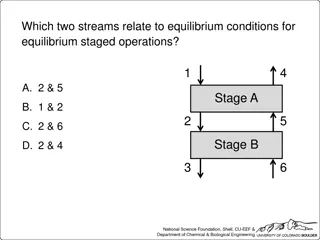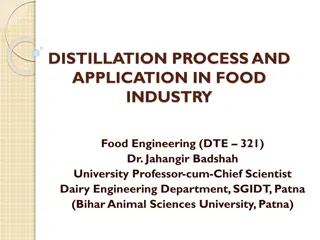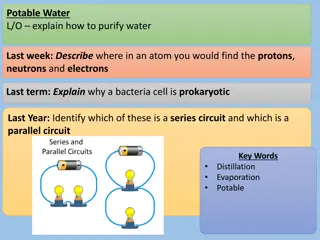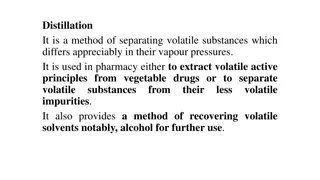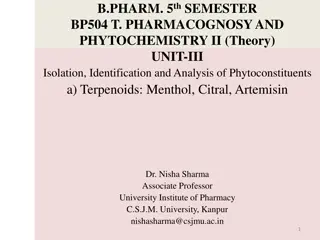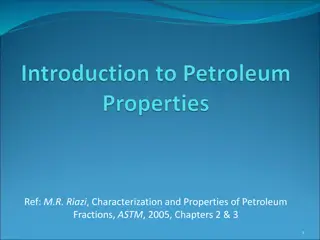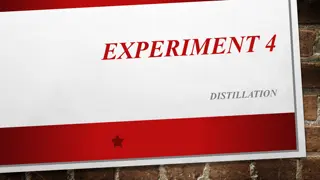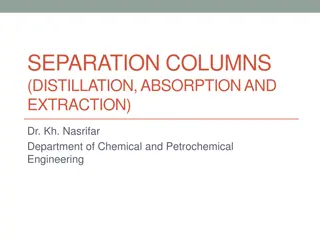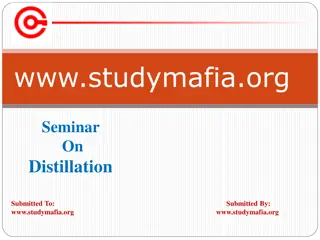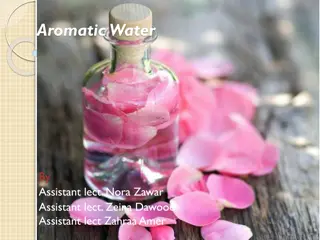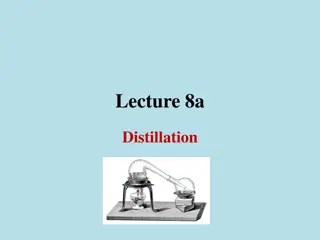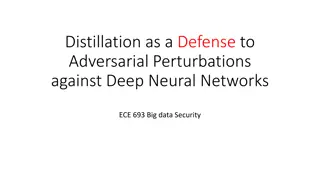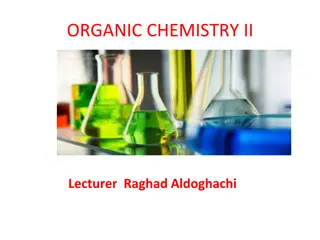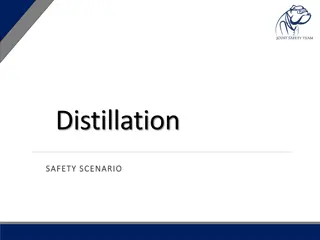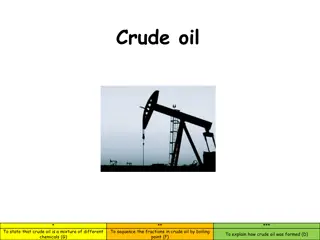Understanding the Basic Principles of Distillation
Distillation is a process used to separate components in a liquid mixture based on differences in vapor pressures. This involves techniques like simple, steam, and fractional distillation, as well as understanding binary mixtures, boiling points, vapor pressures, and vapor-liquid equilibria. Raoult's law, relative volatility, azeotropes, and extractive distillation are also essential concepts in distillation processes.
Download Presentation

Please find below an Image/Link to download the presentation.
The content on the website is provided AS IS for your information and personal use only. It may not be sold, licensed, or shared on other websites without obtaining consent from the author. Download presentation by click this link. If you encounter any issues during the download, it is possible that the publisher has removed the file from their server.
E N D
Presentation Transcript
MODULE IV UNDERSTAND THE BASIC PRINCIPLES OF DISTILLATION
4.1.1 Define Distillation and types of Distillation Equilibrium, simple, steam and fractional distillation. 4.1.2 Vapour liquid equilibria and phase diagram for a binary mixture 4.1.3 Explain Simple Distillation and Steam Distillation with diagram 4.1.4 Define Raoult s law and derive equation ideal and non ideal solutions 4.1.5 Define relative volatility and derive the equation for relative volatility 4.1.6 Solve simple problems related to Raoult s law and relative volatility 4.1.7 Describe maximum and minimum boiling Azeotropes 4.1.8 Compare Azeotropic and Extractive Distillation
DISTILLATION Process of separating the components or substances from a liquid mixture by using selective boiling and condensation Differences in vapour pressures (volatilities) of different constituents at the same temperature is responsible for such a separation Binary Mixture When two liquids are mixed together, they may be miscible with each other in all proportion, such miscible liquid are known as binary mixtures of liquids Example ethanol + water ; acetone + water; benzene + carbon tetrachloride
BOILING POINT Temperature at which the vapour pressure of the liquid equals the external pressure surrounding the liquid. Depends on atmospheric pressure and increases with increase in pressure and vice versa. Normal boiling point of a liquid is the temperature at which its boiling takes place under a pressure of 1 atm. VAPOUR PRESSURE Pressure exerted by vapours of liquid on the surface of liquid when equilibrium is established between liquid and it's vapour Defined as the pressure exerted by a vapour in thermodynamic equilibrium with its condensed phases (solid or liquid) at a given temperature in a closed system, relates to the tendency of particles to escape from the liquid (or a solid). A substance with a high vapour pressure at normal temperatures is often referred to as volatile.
VAPOUR LIQUID EQUILIBRIA Basis of distillation is phase equilibrium specifically,vapour liquid equilibrium (VLE). Boiling diagram of the binary mixture provide the information of the mixture in terms of which components is more volatile(boiling point ) and which is less volatile(higher boiling point) In the boiling point diagram it also show the fraction of the mixture at different temperature and pressure. In mixtures containing two or more components, the concentrations of each component are often expressed as mole fractions.
Consider an example of a liquid mixture containing 2 components (A and B) a binary mixture. Boiling point of A is that at which the mole fraction of A is 1. Boiling point of B is that at which the mole fraction of A is 0. In this example, A is the more volatile component and therefore has a lower boiling point than B. The upper curve in the diagram is called the dew-point curve while the lower one is called the bubble-point curve. Dew-point is the temperature at which the saturated vapour starts to condense. Bubble-point is the temperature at which the liquid starts to boil. Region above the dew-point curve shows the equilibrium composition of the superheated vapour while the region below the bubble-point curve shows the equilibrium composition of the sub cooled liquid.
SIMPLE/DIFFERENTIAL DISTILLATION Process of converting a liquid into its vapour, transferring the vapours to another place , and recovering the liquid by condensing the vapours Vapour formed is immediately channelled into a condenser Also known as differential distillation, as distillation is based on the differences in volatilities and vapour components in the mixture pressures of the Effective only when the boiling point difference between the two liquids is 25 C or more
SIMPLE/DIFFERENTIAL DISTILLATION CONSTRUCTION It consists of a distillation flask with a side arm sloping downwards. Condenser is fitted into the side arm by means of a cork. The condenser is usually water condenser, i.e., jacketed for circulation of water. The condenser is connected to a receiver flask using an adapter with ground glass joints. On a laboratory scale, the whole apparatus is made of glass.
SIMPLE/DIFFERENTIAL DISTILLATION WORKING The liquid to be distilled is filled into the flask to one-half to two- third of its volume. Bumping is avoided by adding small pieces of porcelain before distillation. A thermometer is inserted into the cork and fixed to the flask. The thermometer bulb must be just below the level of the side arm. Water is circulated through the jacket of the condenser. The contents are heated gradually. The liquid begins to boil after some time. The vapour begins to rise up and passes down the side arm into the condenser. The temperature rises rapidly and reaches a constant value, which is equal to the boiling point of the liquid. The vapour is condensed and collected into the receiver. The flame is adjusted so that the distillate is collected at the rate of one to two drops per second. Distillation should be continued until a small volume of liquid remains in the flask.
SIMPLE/DIFFERENTIAL DISTILLATION APPLICATIONS For the preparation of distilled water and water for injection. Volatile and aromatic waters are prepared. Organic solvents are purified. Non-volatile solids are separated from volatile liquids
FLASH/EQUILIBRIUM DISTILLATION Process in which the entire liquid mixture is suddenly vaporized (flash) by passing the feed from a high pressure zone to a low pressure zone. Also known as equilibrium distillation, i.e., separation is attempted when the liquid and vapour phases are in equilibrium. Continuous process PRINCIPLE When a hot liquid mixture is allowed to enter from a high pressure zone into a low- pressure zone, the entire liquid mixture is suddenly vaporised. This process is known as flash vaporisation. During this process the chamber gets cooled. The individual vapour phase molecules of high boiling fraction get condensed, while low boiling fraction remains as vapour.
FLASH/EQUILIBRIUM DISTILLATION WORKING The feed is pumped through a heater at a certain pressure. The liquid gets heated, which enters the vapour-liquid separator through a pressure-reducing valve. Due to the drop in pressure, the hot liquid flashes, which further enhances the vaporisation process. The sudden vaporisation induces cooling. The individual vapour phase molecules of high boiling fraction get condensed, while low boiling fraction remains as vapour.
FLASH/EQUILIBRIUM DISTILLATION WORKING The mixture is allowed for a sufficient time, so that vapour and liquid portions separate and achieve equilibrium. The vapour is separated through a pipe from above and liquid is collected from the bottom of the separator. By continuously feeding into the still, it is possible to obtain continuous flash distillation. The operating conditions can be adjusted in such a way that the amount of feed exactly equals the amount of material removed. Therefore, vapour and liquid concentrations at any point remain constant in the unit. Uses : Flash distillation is used for separating components, which boil at widely different temperatures. It is widely used in petroleum industry for refining crude oil
STEAM DISTILLATION Steam distillation for temperature sensitive materials like natural aromatic compounds. Utilizes distillation at lower temperatures, reducing the deterioration of the desired products. If the substances to be distilled are very sensitive to heat, steam distillation may be applied under reduced pressure, thereby reducing the operating temperature further.
STEAM DISTILLATION CONSTRUCTION Metallic steam can fitted with cork having two holes. Safety tube inserted up to bottom through one hole to maintain pressure in side steam generator Through other hole, band tube is passed and is connected to flask containing non-aqueous liquid in which tube is dipped. Flask and condenser is connected with delivery tube. Condenser is connected to receiver with help of adopter. Provision are made to heat both steam can and flask separately
STEAM DISTILLATION WORKING Steam used to reduce the boiling point of a liquid to be distilled Adding water or steam, the boiling points of the compounds are depressed, allowing them to evaporate at lower temperatures , preferably below the temperatures , preferably below the temperatures at which deterioration of the material becomes appreciable After distillation, vapours condensed, yielding a two phase system of water and organic compounds which can be separated because they are immsicible
STEAM DISTILLATION APPLICATIONS Used to separate immiscible liquids. Ex- Water + Toluene Extraction at much lower temperature to protect from decomposition without loss of aroma To extract volatile oils like clove, anise and eucalyptus oils. Purification of essential oils like almond oil. Camphor is distilled by this method. Aromatic water are prepared. Example : Boiling point of bromobenzene is 156 C and boiling point of water is 100 C, but a mixture of the two boils at 95 C. Thus, bromobenzene can be easily distilled at a temperature 61 C below its normal boiling point.
RECTIFICATION OR FRACTIONATION Used commonly in industries Also known as rectification, because a part of the vapour is condensed and returned as a liquid (reflux) , pure product can be obtained by this method Used to separate miscible volatile liquids, whose boiling points are close, by means of a fractionating column. Fractional distillation is a process in which vaporisation of liquid mixture gives rise to a mixture of constituents from which the desired one is separated in pure form. Rectification enrichment of vapour stream as it passes through a column in contact with reflux
RECTIFICATION OR FRACTIONATION Fractionating column or fractionator consist of (i) cylindrical shell divided into sections by a series of perforated trays (ii) reboiler (iii) condenser Tray Liquid mixture to be separated is introduced in the cylindrical column more or less centrally Column divide into rectifying and stripping sections Tray Section above the feed plate or tray is called rectifying section, where in vapour is washed to remove the less volatile component with the liquid returned to the column from top (known as reflux). Portion below the feed plate including the feed plate is called stripping section wherein the liquid is stripped off more volatile component by rising vapour.
RECTIFICATION OR FRACTIONATION Perforated trays are liquid gas contacting devices on which gas/vapour and liquid are brought into intimate contact for mass transfer to occur Vapours generated reboiler are fed to the bottom of the column. Tray Bottom product - liquid rich in the less volatile component Vapour rising from top of the column is fed to a condenser where Tray the latent heat is removed with the help of a circulated coolant through the condenser. A part of the condensed liquid is returned to the column (reflux)
RECTIFICATION OR FRACTIONATION Remaining part withdrawn as the top product or distillate which is rich in more volatile component. As we move up, the vapour becomes richer and richer in the more volatile component and as we move down the column, the Tray liquid becomes richer and richer in less volatile component. As the liquid is at its bubble point and the vapour is at its dew point, temperature is maximum at the bottom and minimum at the Tray top. The part of the condensed liquid returning to the top of the column is called reflux.
RECTIFICATION OR FRACTIONATION APPLICATIONS Purification of water as well as separating acetone and water. Oil refineries and chemical plants mainly for purification and separation of many organic compounds. Crude oil refining
SIMPLE DISTILLATION to separate miscible liquids with sufficiently large differences in their boiling points vapour is directly passed through the condenser FRACTIONAL DISTILLATION Used when the difference in boiling points is quite less Used mixture of vapour must pass through a fractionating column in which partial condensation of vapour is allowed to occur Condensate is collected directly into the receiver Condensation takes place in the fractionating column, so that a part of the condensing vapour returns to the still. E.g. Crude oil refining E.g. Sea water purification
RAOULTS LAW Used for predicting the vapour liquid equilibrium for an ideal solution It states that the equilibrium partial pressure of a constituent/ component in a solution at a given temperature is equal to the product of its vapour pressure in the pure state and its mole fraction in the liquid state. pAand pB- equilibrium partial pressure of A and B pAo and pBo - vapour pressure of A and B in the pure state and xA and xB - mole fraction of A and B in the liquid phase, then Partial pressure - pressure exerted by an individual gas in a mixture
DALTONS LAW It states that in a mixture of non-reacting gases, the total pressure exerted is equal to the sum of the partial pressure of the individual gases This empirical law was observed by John Dalton in 1801 and is related to the ideal gas laws
IDEAL SOLUTIONS An ideal solution is that solution that follows Raoult s law under all standard temperature and concentration Consider two liquids A and B, and mix them. The formed solution will experience several intermolecular forces of attractions inside it, which will be: A A intermolecular forces of attraction B B intermolecular forces of attraction A B intermolecular forces of attraction The solution is said to be an ideal solution, only when the intermolecular forces of attraction between A A, B B and A B are nearly equal. Examples n-hexane and n-heptane ; Bromoethane and Chloroethane, Benzene and Toluene etc.
NON IDEAL SOLUTIONS The solution which do not follow Raoult s law It is the solution in which solute and solvent molecules interact with one another with a different force than forces of interaction between the molecules of the pure compounds. Example Sulphuric acid(solute) and water(solvent) the amount of heat is evolved is large and thus change in volume is also seen.
CHARACTERISTICS OF IDEAL AND NON IDEAL SOLUTION IDEAL SOLUTION pA= pA0. xA ; pB= pB0. xB Hmix=0 Vmix=0 NON IDEAL SOLUTION pA= pA0. xA ; pB= pB0. xB Hmix=0 Vmix=0
NON IDEAL SOLUTIONS +ve -ve deviation deviati0n pA >pA0 . xA ;pB >pB0 . xB pA <pA0 . xA ;pB <pB0 . xB PTOTAL > PA + PB PTOTAL < PA + PB Hmix > 0 Vmix > 0 Hmix <0 Vmix <0
Derive an equation connecting mole fraction and vapour of a binary mixtures by applying Raoult s law and Dalton s law OR Explain Raoult s law and derive its equation. 1 Raoult s law Dalton s law 2 For an ideal gas or vapour, the partial pressure is related to the mole fraction of the component in gas or vapour phase by the relation: Partial pressure = mole fraction Total pressure Thus , for component A , 3 pA = yA . P yA = mole fraction of A in vapour phase
Knowing the vapour pressures of components A (more volatile) and B at various values of temperatures, x-y data can be generated for an ideal solution as follows: 5 pB = pB0 . (1- xA ) pA = pA0 . xA 4 pA = yA . P pB = yB . P 6 7 From equations 4 and 6, we get yA . P = pA0 . xA 8 yA= pA0 . xA P 9 yB= pB0 . xB P 10
yA + yB= 1 xA =1 - xA We have Substituting for yA and yB from equations 9 & 10 and xB in terms of xA , above equation becomes pA0 . xA P P pB0 . (1-xA ) = 1 + pA0 . xA pB0 . (1-xA ) = P + Rearranging the above equations, we get xA= P - pB0 pA0 - pB0 11
VOLATILITY Tendency of a substance to vaporize Related directly to vapour pressure Volatility - defined as the ratio of partial pressure of the substance in vapour phase to the mole fraction of the substance in the liquid phase Volatility of A = pA Volatility of B = pB 1 2 xA xB Relative Volatility of a component A with respect to component B is the ratio of the volatility of A (more volatile) to the volatility of B and denoted by the symbol AB . AB= pA .xB pB .xA 3
But, pA = yA . P pB = yB . P 4 5 Substituting equations 4 & 5 in equation 3 AB= yA .xB yB 6 .xA AB= yA /yB xA /xB 7 Thus, Relative Volatility is the ratio of concentration ratio of A to B in the vapour phase to that in the liquid phase We have, 8 yA + yB= 1 xA =1 - xA
AB= yA . (1-xA ) (1-yA ) xA 9 On solving, we get yA = AB . xA 1+ ( 10 AB -1)xA Dropping subscripts , we get y = . x 1+ ( -1)x 11 From the above equation , knowing for a given binary system, x-y data (equilibrium data) can be generated by taking x =0,0.1,0.2 to 1 and evaluating corresponding values of
AZEOTROPES Azeotropes or constant boiling mixture is a mixture of two or more liquids whose proportion cannot be altered by simple distillation When an azeotrope is boiled, the vapour has the same proportions of constituents as the unboiled mixture Types of Azeotropes: Maximum Boiling Azeotrope Minimum Boiling Azeotrope
MINIMUM BOILING AZEOTROPE Boiling point of an azeotrope is less than the boiling point temperatures of any of its constituents is called minimum boiling azeotropes Exhibits positive deviation from Raoult s law (e.g.: Ethanol (95.5 %) and water (4.5 %) form minimum boiling azeotrope at boiling temperature of 351.5 K).
MAXIMUM BOILING AZEOTROPE Boiling point of an azeotrope is more than the boiling point temperatures of any of its constituents is called maximum boiling azeotropes Exhibits negative deviation from Raoult s law (e.g.: Nitric Acid (68%) and water (32%) form maximum boiling azeotrope at boiling temperature of 393.5 K)
CHARACTERISTICS OF MAXIMUM AND MINIMUM BOILING AZEOTROPE MAXIMUM BOILING AZEOTROPE Boiling point higher than the boiling points of its constituents MINIMUM BOILING AZEOTROPE Boiling point lower than the boiling points of its constituents Interaction between the solvent-solvent and solute-solute molecules are stronger than solvent-solute molecules which results in their high boiling point Interaction between the solvent-solvent and solute-solute molecules are weaker than solvent-solute molecules which results in their low boiling point Volume of the solution is lower than the sum of the individual volumes of the constituents because of high solute-solvent molecular interaction. Volume of the solution is higher than the sum of the individual volumes of the constituents because of low solute-solvent molecular interaction Enthalpy of the mixture of its constituents is negative. Enthalpy of the mixture of its constituents is positive.
AZEOTROPIC DISTILLATION Constituents of a binary azeotrope are separated by (a) adding a third component to the binary mixture (b) changing the system pressure. The third component (which is relatively volatile) added to a binary azeotrope usually forms a low boiling azeotrope with one of the feed constituents and withdrawn as the overhead product or distillate. The third component added to break the binary azeotrope to effects its separation into pure components is called the entrainer/azeotrope breaker and this process of distillation is called azeotropic distillation Example : separation of ethanol with water using benzene as entrainer
AZEOTROPIC DISTILLATION Benzene breaks the mixture of ethanol and water and forms a new azeotrope between benzene and ethanol Volatility of water (more polar liquid ) is enhanced On distillation , water distils at 65.85 C leaving alcohol and benzene behind Boiling point of this binary mixture is 68.2 C and benzene gets distilled leaving alcohol behind Alcohol distilled at 78.3 C



